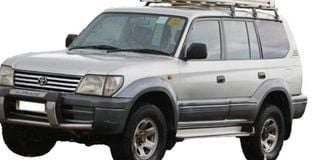Pajero vs Prado

This second generation Prado was in production from 1996-2002. It is still a popular SUV in Uganda. PHOTO BY ISMAIL KEZAALA
I have driven a Honda Odyssey for seven years. I want to buy either a Pajero Exceed or Land Cruiser Prado TX. Which of the two is a better choice for Ugandan roads considering durability, fuel consumption, comfort and maintenance? I would like to drive it for at least seven years. Dennis.
Mitsubishi and Toyota are “go anywhere” vehicles. Their good off-road and on road credentials are recognised globally. They both joined the sports utility vehicle (SUV) market segment to win the field work oriented and outdoor adventure loving market segment. Mitsubishi’s SUV was called “Leopardus Pajero” meaning “the Pampas Cat” and “Montero” the “mountain hunter” for the European market.
Toyota named their new SUV “Prado” which means “a fine work of art.” In this edition of head-to-head, we compare the 1999 third generation Mitsubishi Pajero 3.2 litre common rail diesel and the upgraded second generation 1999 Toyota Land Cruiser Prado 3.0 litre turbo diesel. Both SUVs are popular on the Ugandan used car market.
Performance
The Pajero’s bigger 3.2 litre turbo diesel engine sets a high performance standard for the Prado’s 3.0 litre turbo diesel. Pajero’s engine accelerates faster, has greater pulling power and better fuel economy compared to Prado. This is due to its Direct Injection Diesel (DiD) common rail fuel delivery system which ensures timely and proportional injection of diesel into the engine combustion chamber through a high pressure. This works well with the Double Overhead Camshaft (DOHC) valve train to ensure smooth effortless acceleration and economy. Prado’s smaller 3.0 litre inter cooler turbo diesel engine has some ‘kick’ in it but does not match Pajero’s “punch.”
Pajero’s manu-matic (tip-tronic) auto transmission allows more driver control of the automatic transmission. This innovation automatically intervenes to rectify inefficient gear selection as well as allowing manual selection of gears making the Pajero faster and more economical to drive.
Handling
Pajero’s Super Select 4 (SS4ii) and Prado’s four wheel drive systems have electronic low range to high range transfer. One only needs to push an electric button or turn a knob when difficult terrain is encountered. The result is convenient shifting on the move and driver attention to navigation and maneuvering.
Pajero’s lower ground clearance and wider wheel base gives it a better centre of gravity and road holding.
Pajero has reduced body roll on the highway sharp bends compared to the Prado, which has a higher ground clearance and centre of gravity. Both Pajero and Prado have good off-road handling manners due to their unibody integrated chassis and structure. Unibody chassis offers a better torsional rigidity for extreme driving stress. This feature is useful when driving fast around sharp bends on the highways or over bumpy upcountry roads.
Pajero and Prado have independent front and rear suspension (double wishbone, coil springs and stabilisers) and the four wheel drive systems allow them reasonable access to off-road terrain.
Styling and comfort
The third generation Pajero styling and design was inspired by the performance of its Pajero Evolution in the Paris-Dakar rally. The sculptors of the new Pajero continued the Evolution from the old “tall boxy shape” with a more aerodynamic sporty look which has pronounced fender flares and swept back headlights.
Prado’s exterior styling is more conservative and practical. While Prado is sleeker and better looking than its predecessor, it does not emphasise flair and style the way Pajero does.
Interior styling of both SUVs is quite impressive with easy-to-see dials and knobs. Both vehicles have less plastic materials in the interior furnishing compared to their predecessors. Pajero’s interior is quite roomy and the seats wide and comfortable. Prado’s rear passenger seating space is less generous and the seats stiff and narrower.
Both SUVs offer modern comfort amenities such as air conditioning, power windows and radio CD audio entertainment. Pajero and Prado offer two extra seats in the third row, which are useful for the typical Ugandan family. Clearly, Pajero steps out stronger in the styling, design and comfort segment.
Safety
Pajero and Prado are fitted with anti-lock brake systems (ABS), front passenger airbags, modern seat belts with inertia reel locking mechanisms and reinforced chassis and body structures. They are both safe vehicles to drive.
Reliability and resale value
Pajero and Prado are strong and reputable go anywhere vehicles. Their slow and fast moving parts are available and accessible both their appointed dealers and independent suppliers around town. Used body, engine and suspension parts are also available for the budget constrained buyers.
On the whole, Pajero slow moving parts (suspension, engine rebuild and body parts) are more expensive, while the fast moving parts (filters) are the same price as Prado’s. The Prado has a better resale value because of buyer perception that it is easier to maintain in the long run.
Verdict
Prado is a tough and reputable vehicle but it meets an adversary (Pajero), which has been designed with modern engine and transmission technology to compete in the renowned challenging Paris Dakar rally. Prado wins three stars for good off-road handling, good safety standards and better resale value due to better long-term maintenance costs. Mitsubishi Pajero wins with four star points for better engine performance, good handling on and off-road, superior styling and safety record.




